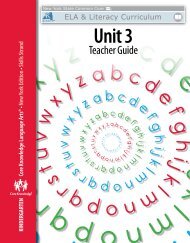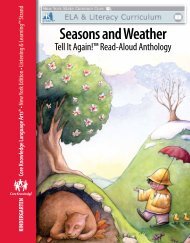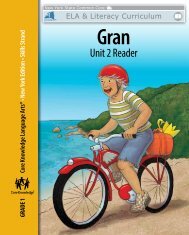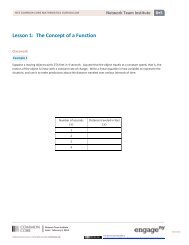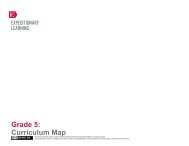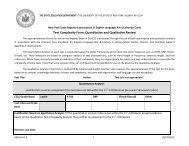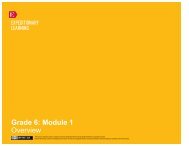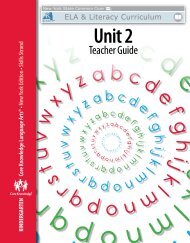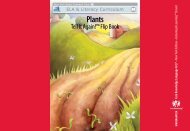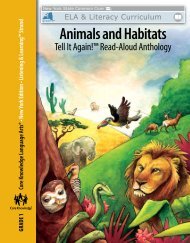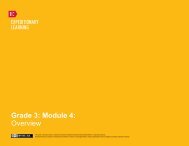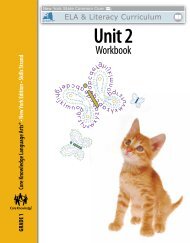Tell It Again! Read-Aloud Anthology - EngageNY
Tell It Again! Read-Aloud Anthology - EngageNY
Tell It Again! Read-Aloud Anthology - EngageNY
Create successful ePaper yourself
Turn your PDF publications into a flip-book with our unique Google optimized e-Paper software.
Show image 4A-6: Painting of Sequoyah and his writing system<br />
17 Was Sequoyah successful at making<br />
sure that the Cherokee language<br />
would never fade away?<br />
18 [You may wish to tell students that<br />
the Cherokee language is still kept<br />
alive due to modern technology,<br />
such as the Internet.]<br />
After all of his hard work, Sequoyah’s writing system was<br />
accepted. He and Ayoka taught other Cherokee people to use the<br />
symbols—and that is how the Cherokee people learned to read<br />
and write. 17<br />
Later, many sad things happened to the Cherokee people. In<br />
the 1830s they were forced to leave their lands. Later they were<br />
forced onto reservations and into English-speaking classrooms.<br />
Thanks to Sequoyah’s hard work, the Cherokee were able to keep<br />
their language alive. Even today, almost two hundred years later,<br />
the Cherokee language is written with symbols developed by<br />
Sequoyah. 18<br />
Show image 4A-7: Photographs of Sequoyah statue and sequoia trees<br />
19 [Point to the statue and the<br />
sequoia trees in the image. Note<br />
that the spelling of the tree and<br />
the man are different.]<br />
Sequoyah is remembered and honored as the man who taught<br />
his people to read and write. However, he is not only honored by<br />
the Cherokee people, he is considered to be a national hero, too.<br />
There is a statue of Sequoyah in the U.S. Capitol building. And, it<br />
is believed that the tall, strong sequoia trees that grow in California<br />
may have been named to honor the man who allowed his people<br />
to stand a little taller, too. 19<br />
Discussing the <strong>Read</strong>-<strong>Aloud</strong><br />
Comprehension Questions<br />
15 minutes<br />
10 minutes<br />
If students have difficulty responding to questions, reread pertinent<br />
lines of the read-aloud and/or refer to specific images. If students<br />
give one-word answers and/or fail to use read-aloud or domain<br />
vocabulary in their responses, acknowledge correct responses by<br />
expanding students’ responses using richer and more complex<br />
language. Ask students to answer in complete sentences by<br />
having them restate the question in their responses.<br />
1. Evaluative What was the main topic of the read-aloud?<br />
(Sequoyah and the Cherokee writing)<br />
2. Literal Was Sequoyah always famous? (no) What made him<br />
famous? (He created a writing system for the Cherokee.)<br />
62 Westward Expansion 4A | The Story of Sequoyah<br />
© 2013 Core Knowledge Foundation



